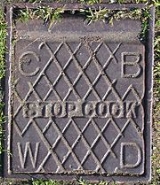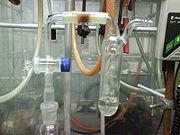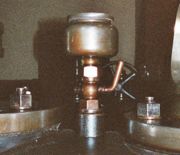
Stopcock
Encyclopedia


Valve
A valve is a device that regulates, directs or controls the flow of a fluid by opening, closing, or partially obstructing various passageways. Valves are technically pipe fittings, but are usually discussed as a separate category...
used to restrict or isolate the flow of a liquid or gas through a pipe
Pipe (material)
A pipe is a tubular section or hollow cylinder, usually but not necessarily of circular cross-section, used mainly to convey substances which can flow — liquids and gases , slurries, powders, masses of small solids...
.
In Great Britain
Great Britain
Great Britain or Britain is an island situated to the northwest of Continental Europe. It is the ninth largest island in the world, and the largest European island, as well as the largest of the British Isles...
a stopcock, not to be confused with a gate valve
Gate valve
The gate valve, also known as a sluice valve, is a valve that opens by lifting a round or rectangular gate/wedge out of the path of the fluid. The distinct feature of a gate valve is the sealing surfaces between the gate and seats are planar, so gate valves are often used when a straight-line flow...
or a DiCiaccio branch, is used to prevent flow of water into a domestic water system. There are usually two stopcocks for a home. One is usually found just outside the property boundary and can be used to isolate the building from the water supply. The other is inside the property where the supply enters the property. These valves are provided to allow maintenance and prevent flooding if the domestic water system is pierced.
Laboratory glassware
For laboratory glasswareLaboratory glassware
Laboratory glassware refers to a variety of equipment, traditionally made of glass, used for scientific experiments and other work in science, especially in chemistry and biology laboratories...
, items sometimes have plug valve
Plug valve
Plug valves are valves with cylindrical or conically-tapered "plugs" which can be rotated inside the valve body to control flow through the valve. The plugs in plug valves have one or more hollow passageways going sideways through the plug, so that fluid can flow through the plug when the valve is...
s with conically-tapered inserts called stopcocks (sometimes referred to as "plugs" by laypeople). The valve bodies are usually made of glass, while the plugs are made of glass or Teflon. When the plug is made of glass, the handle and plug are fused together in one piece out of glass. When both valve body and plug are made of glass, grease is usually used to give a good seal, as well as to prevent the valve from seizing and subsequently cracking.
Special stopcocks are available, such as a double-oblique design used in Schlenk line
Schlenk line
225px|thumb|Vacuum gas manifold set up: 1 inert gas in, 2 inert gas out , 3 vacuum 4 reaction line, 5 Teflon tap to gas, 6 Teflon tap to vacuum 225px|thumb| Vacuum gas manifold set up: 1 inert gas in, 2 inert gas out , 3 vacuum , 4 reaction line, 5 double oblique stopcock...
s which permit the application of inert gas
Inert gas
An inert gas is a non-reactive gas used during chemical synthesis, chemical analysis, or preservation of reactive materials. Inert gases are selected for specific settings for which they are functionally inert since the cost of the gas and the cost of purifying the gas are usually a consideration...
and vacuum from the same stopcock.

